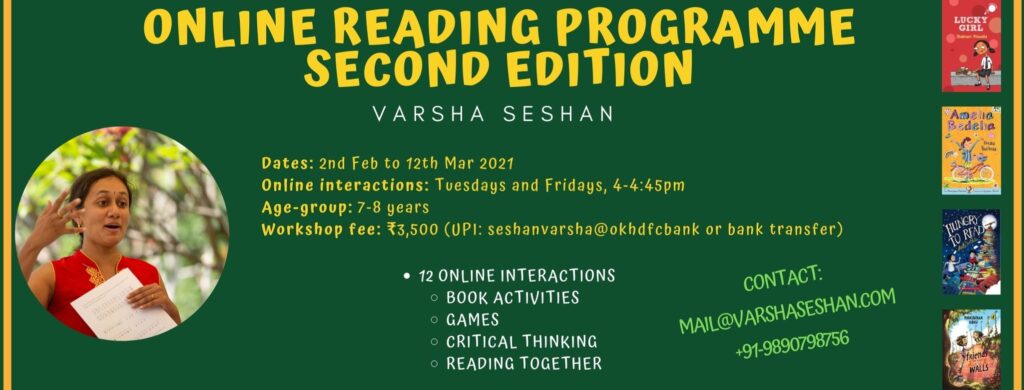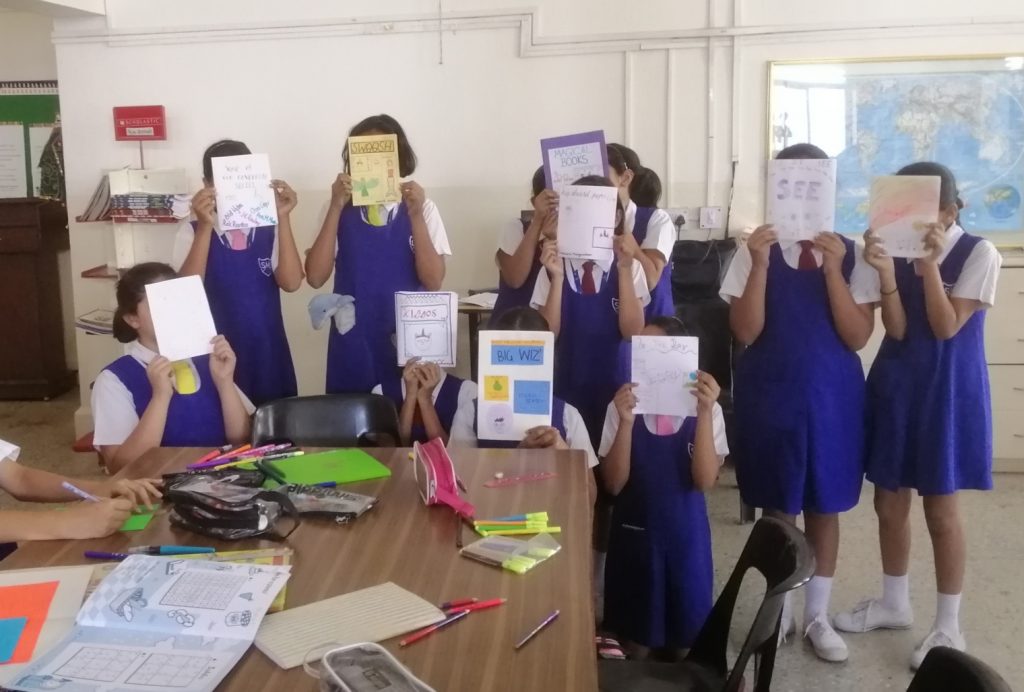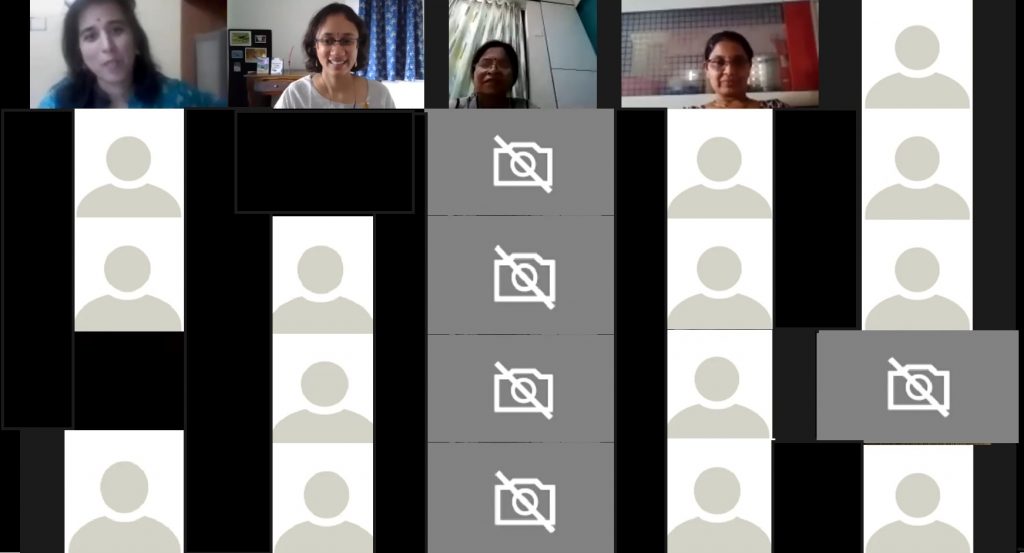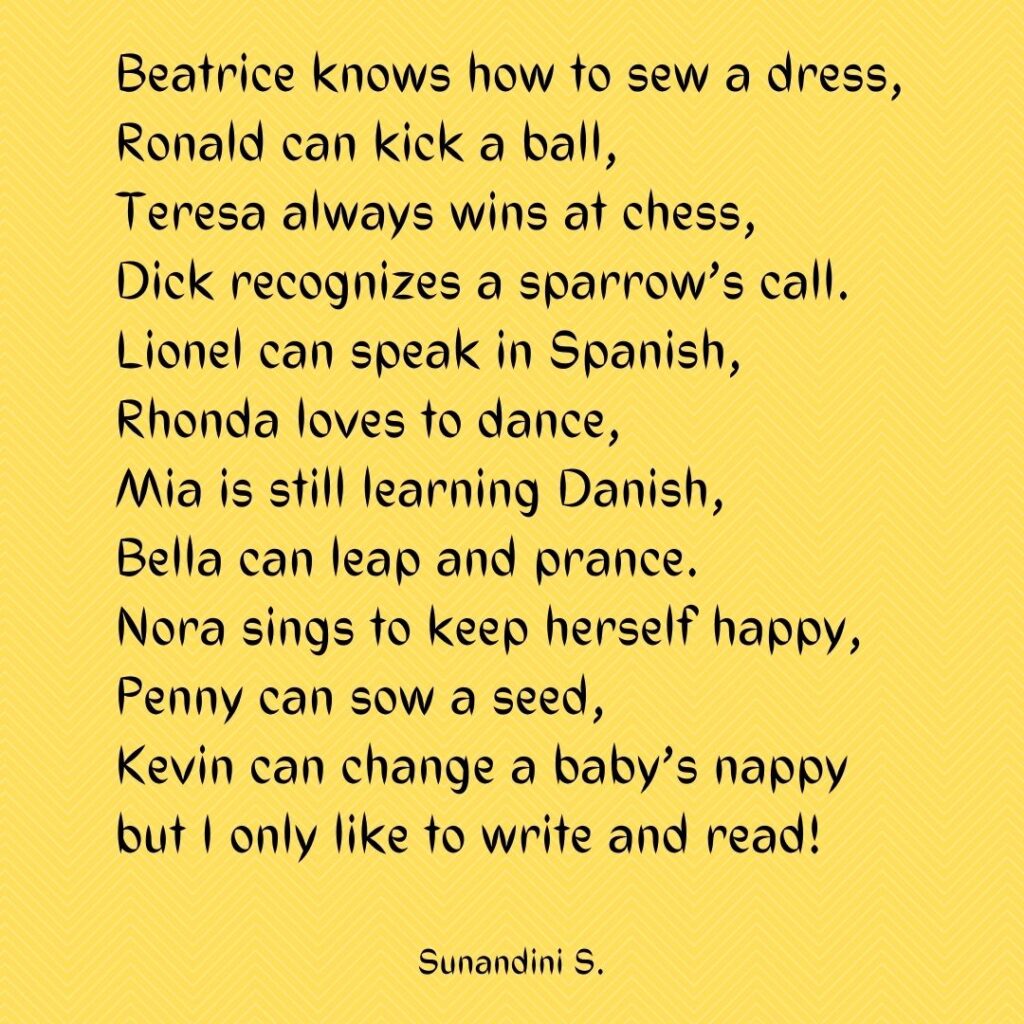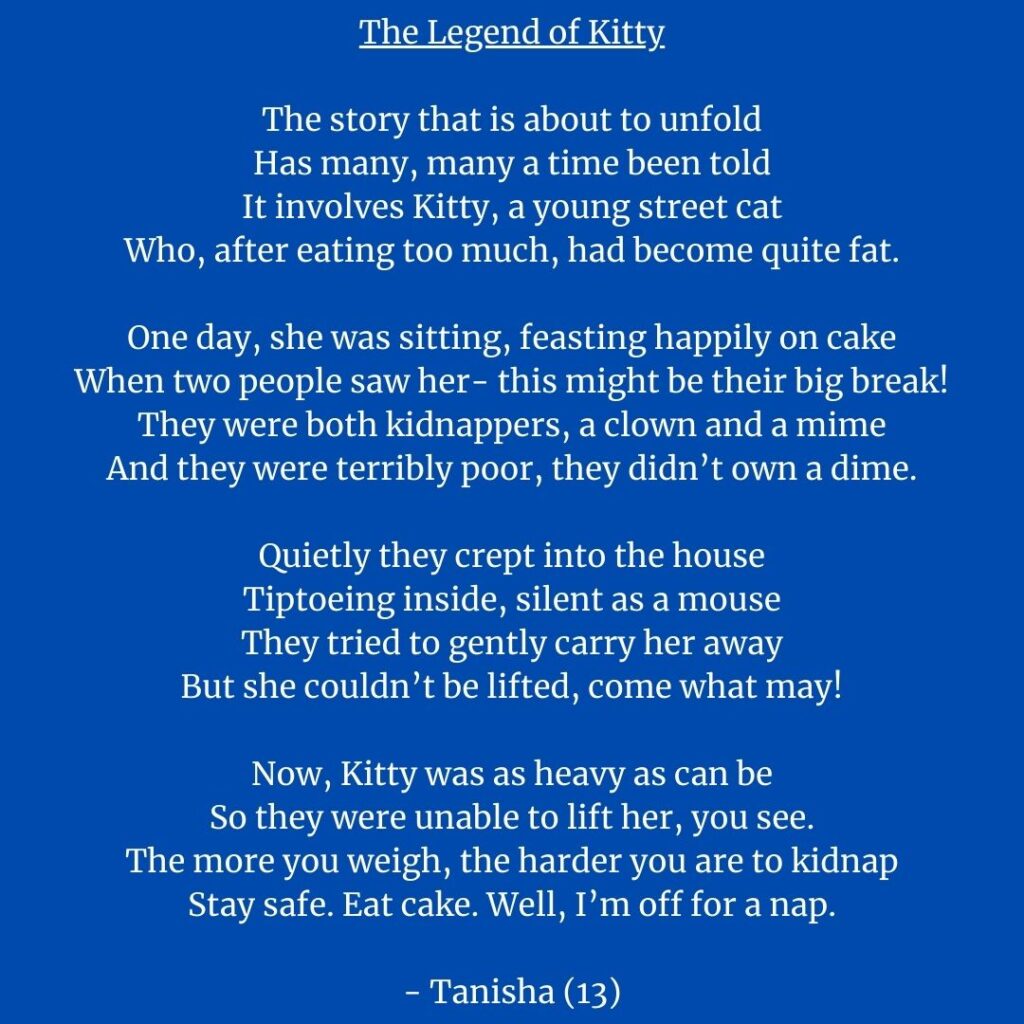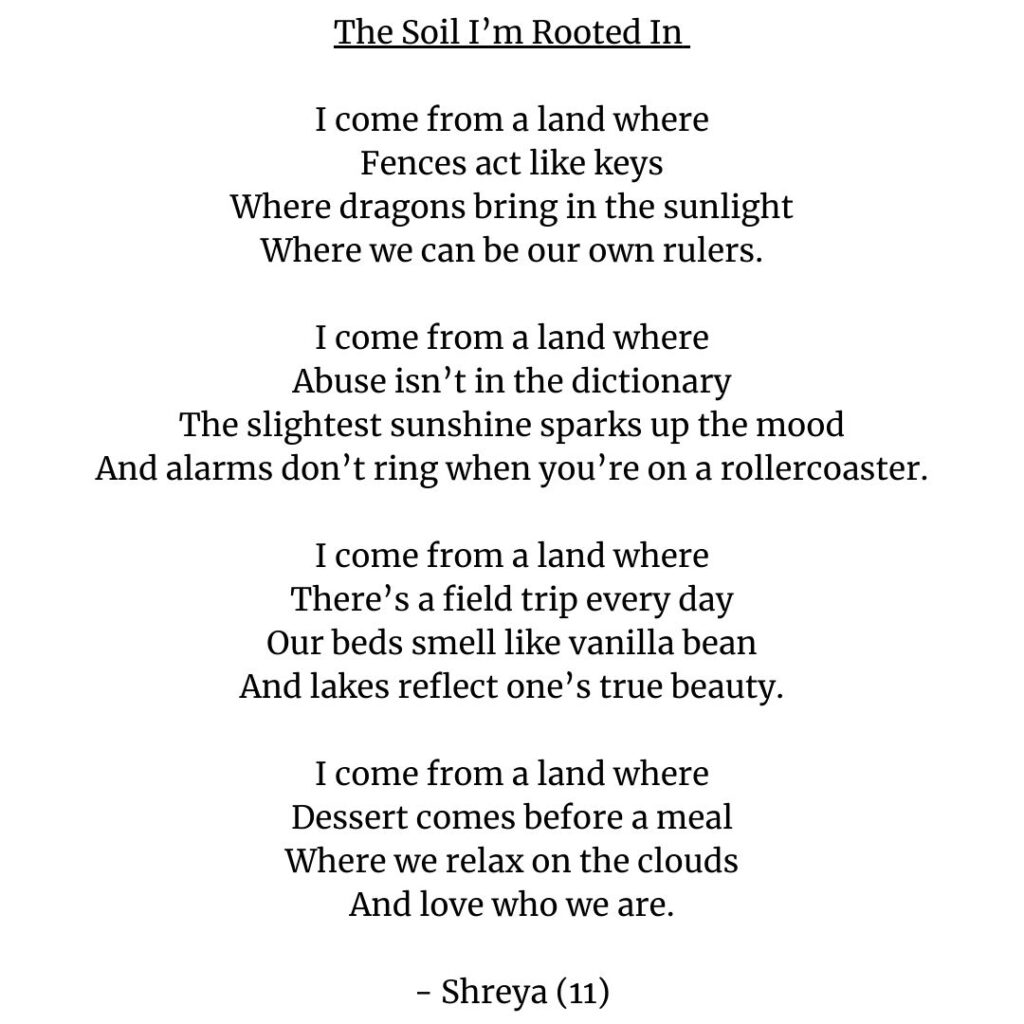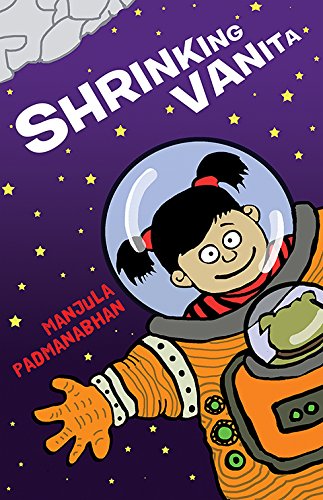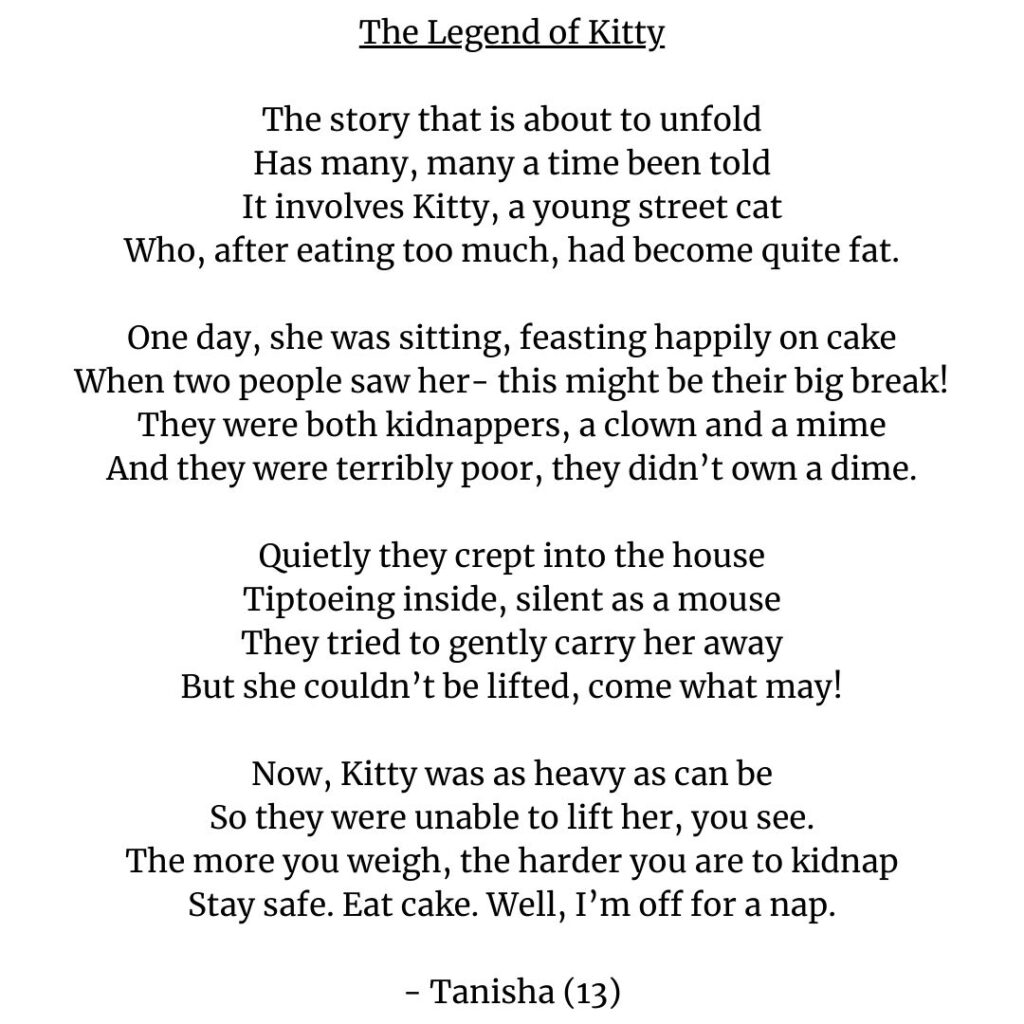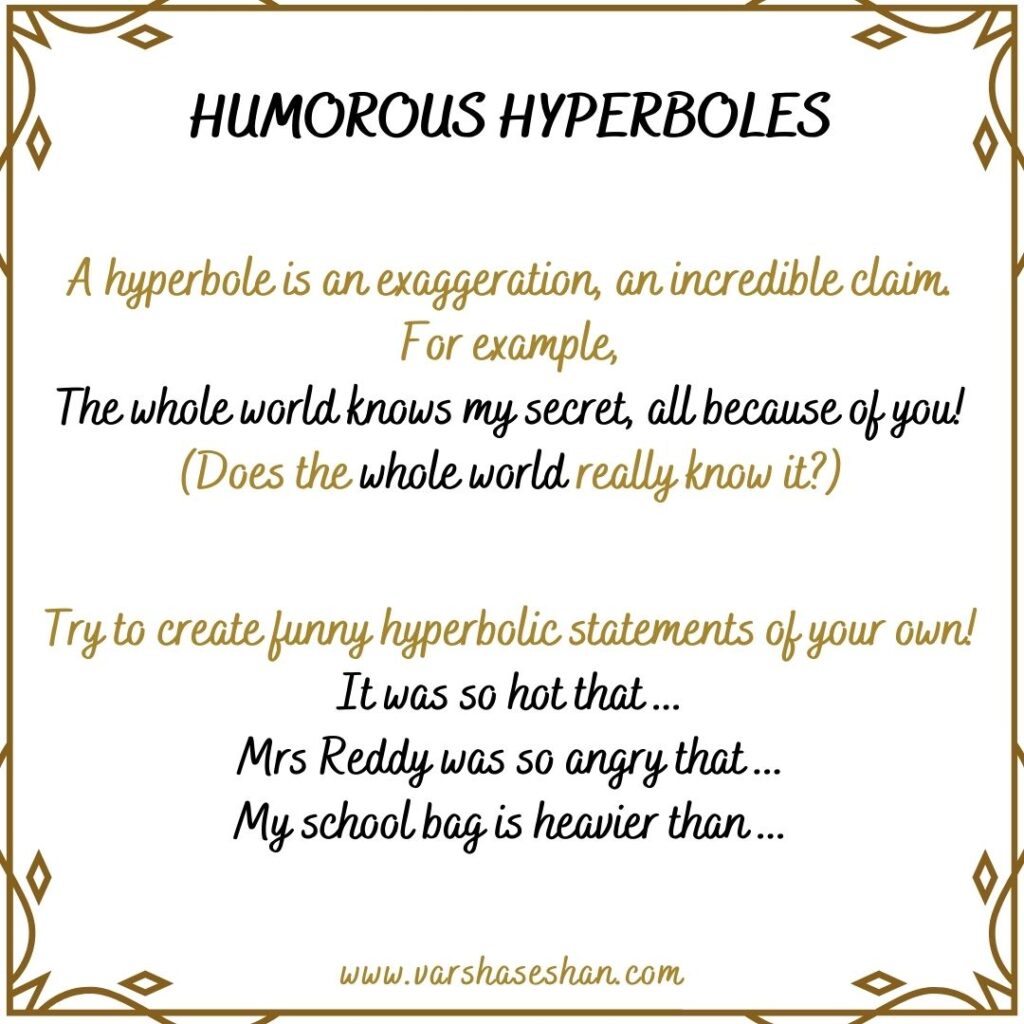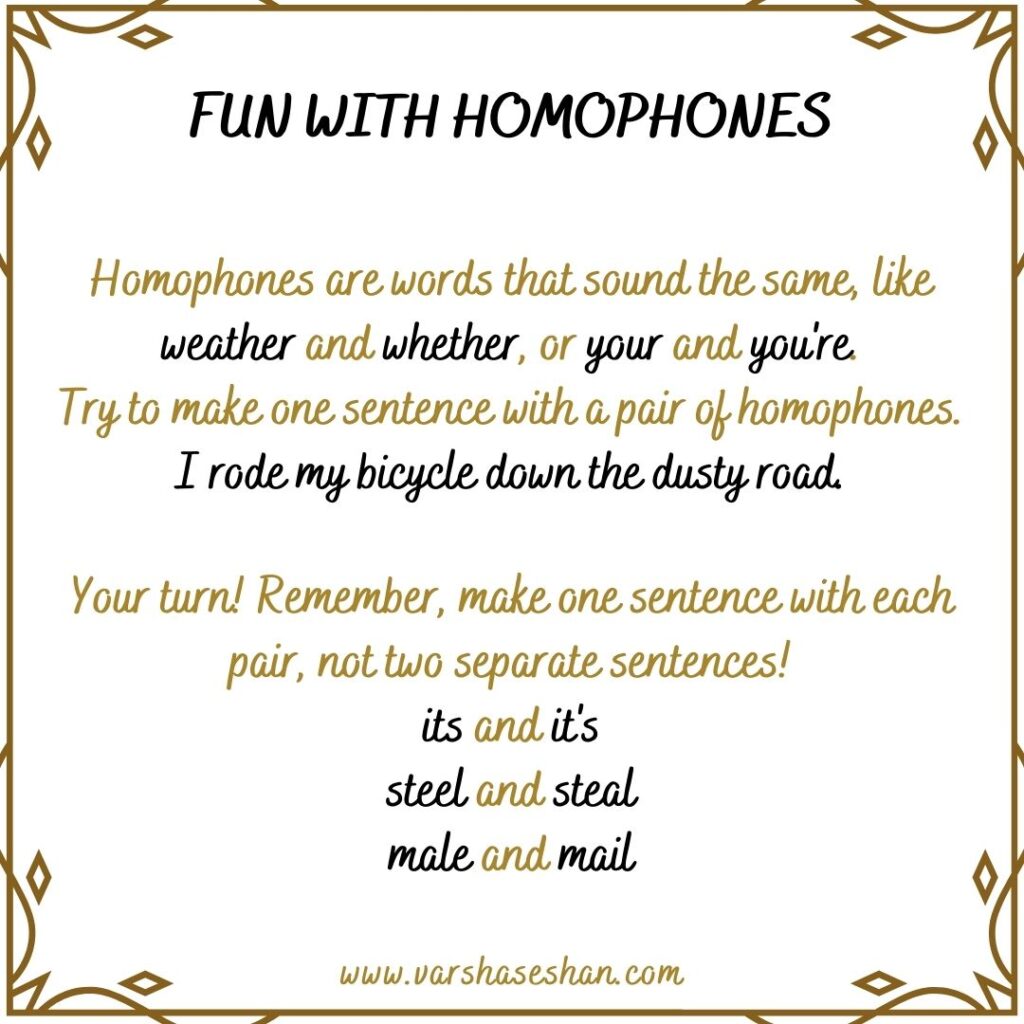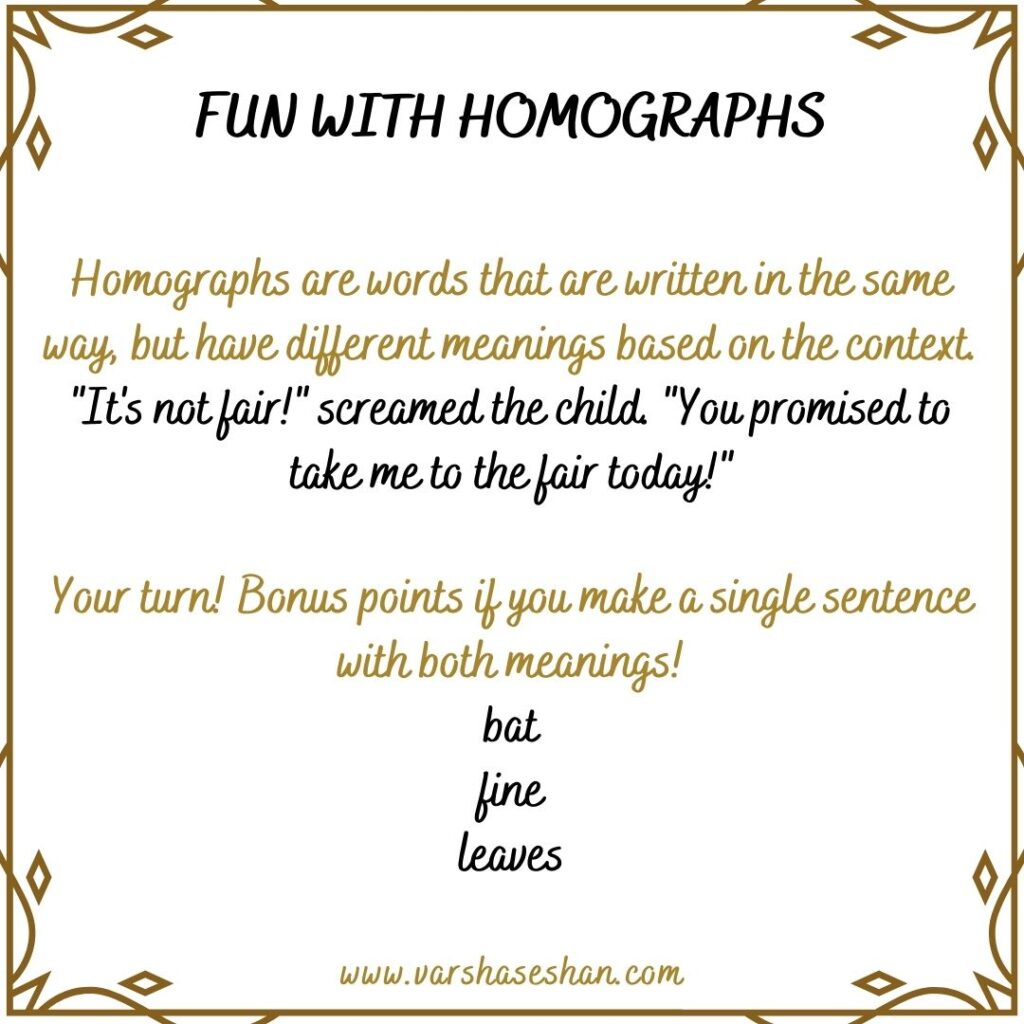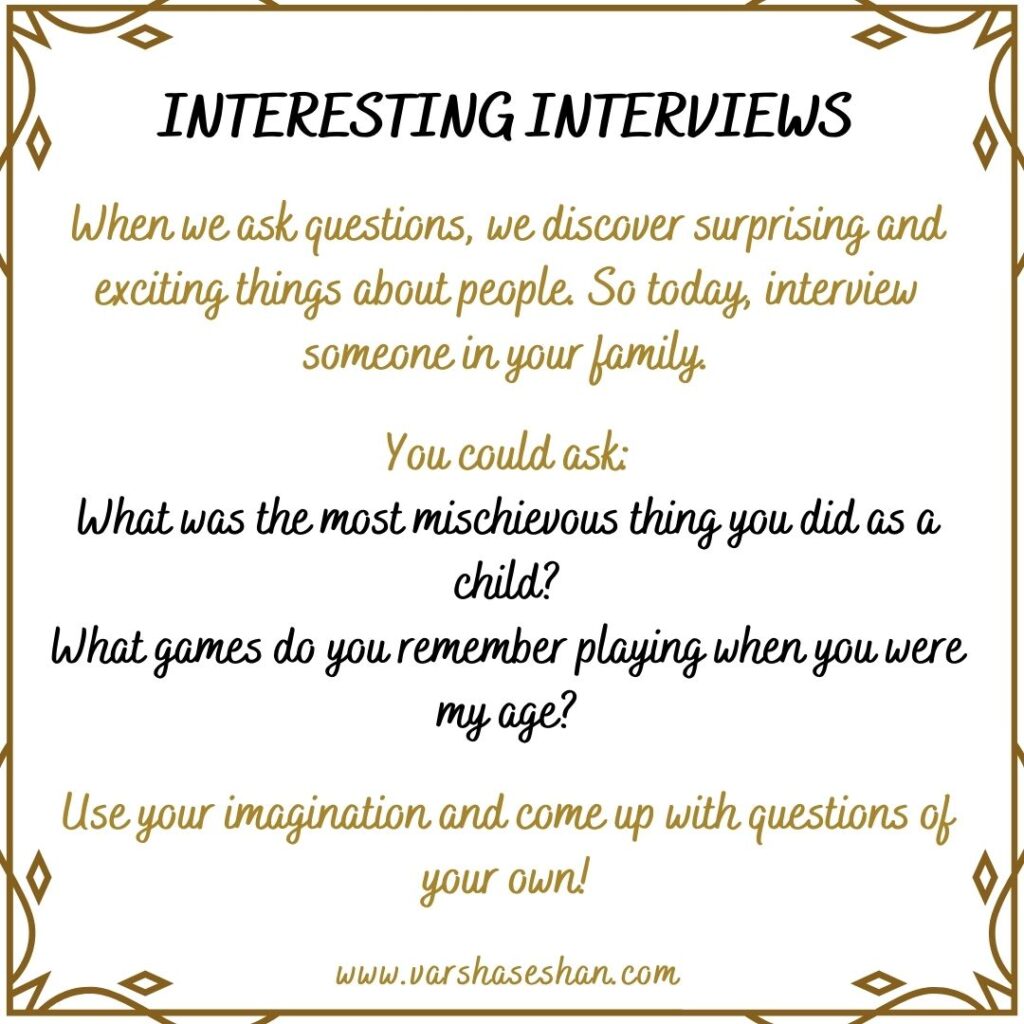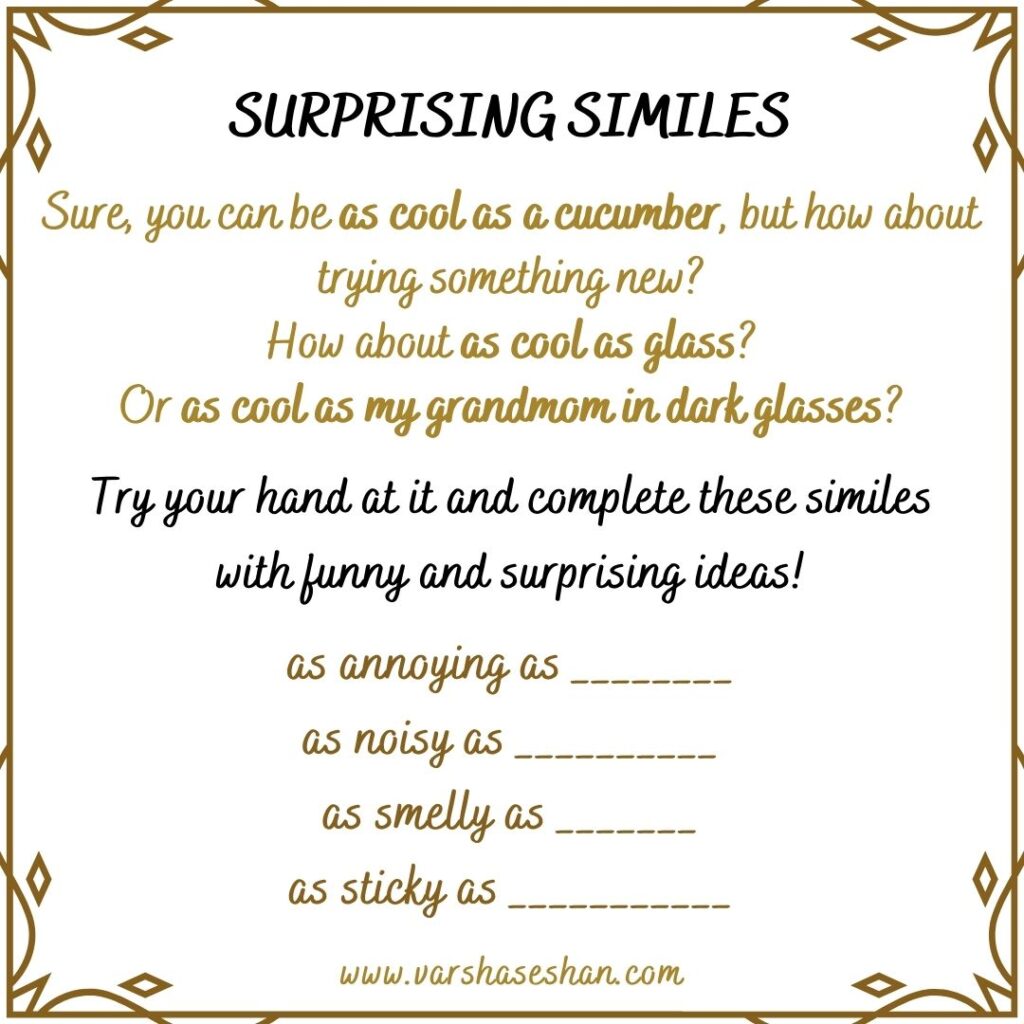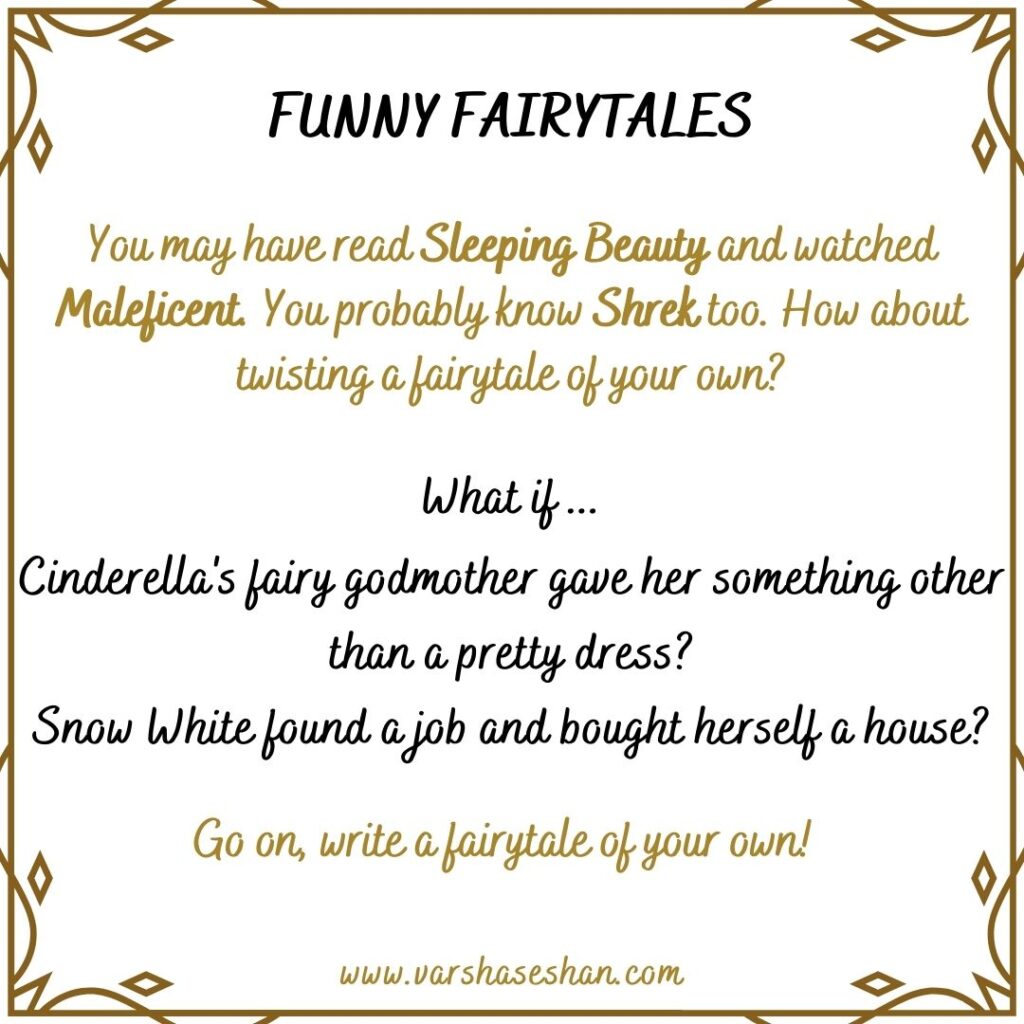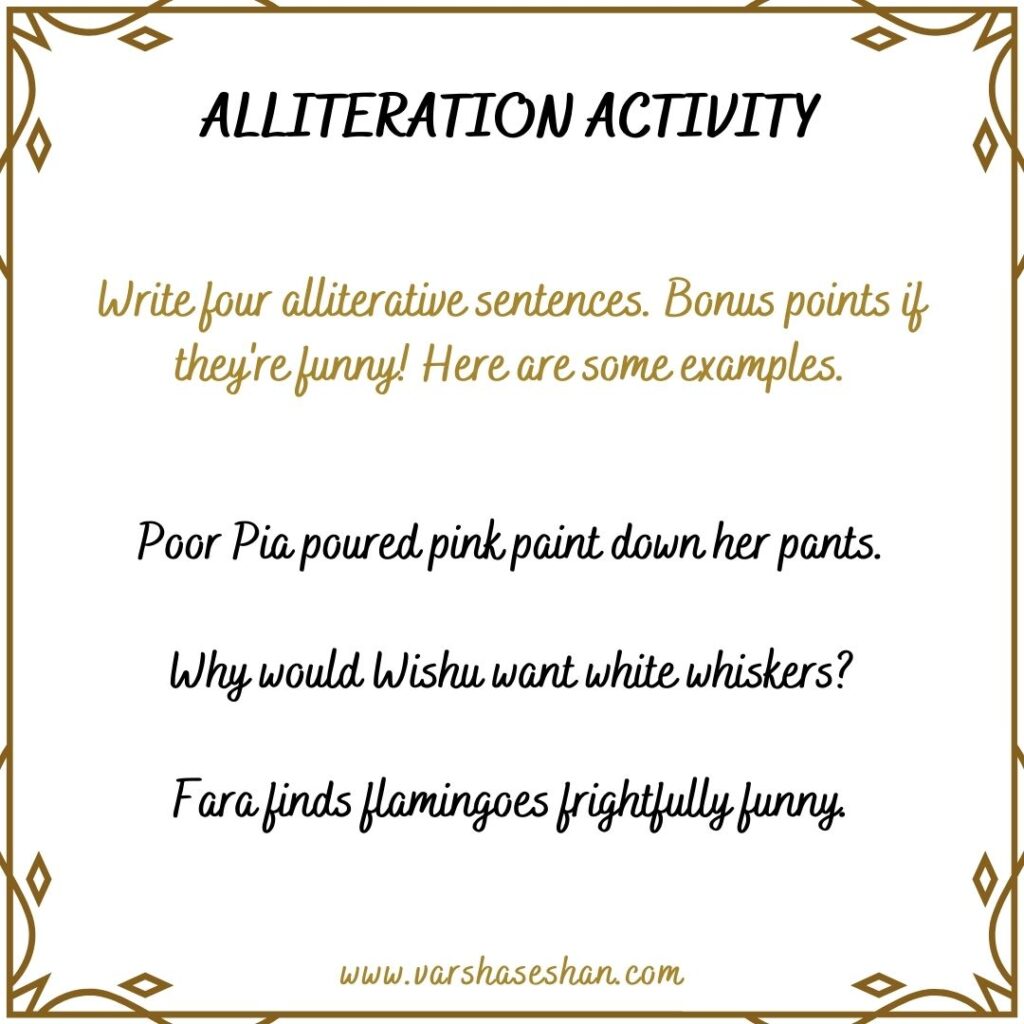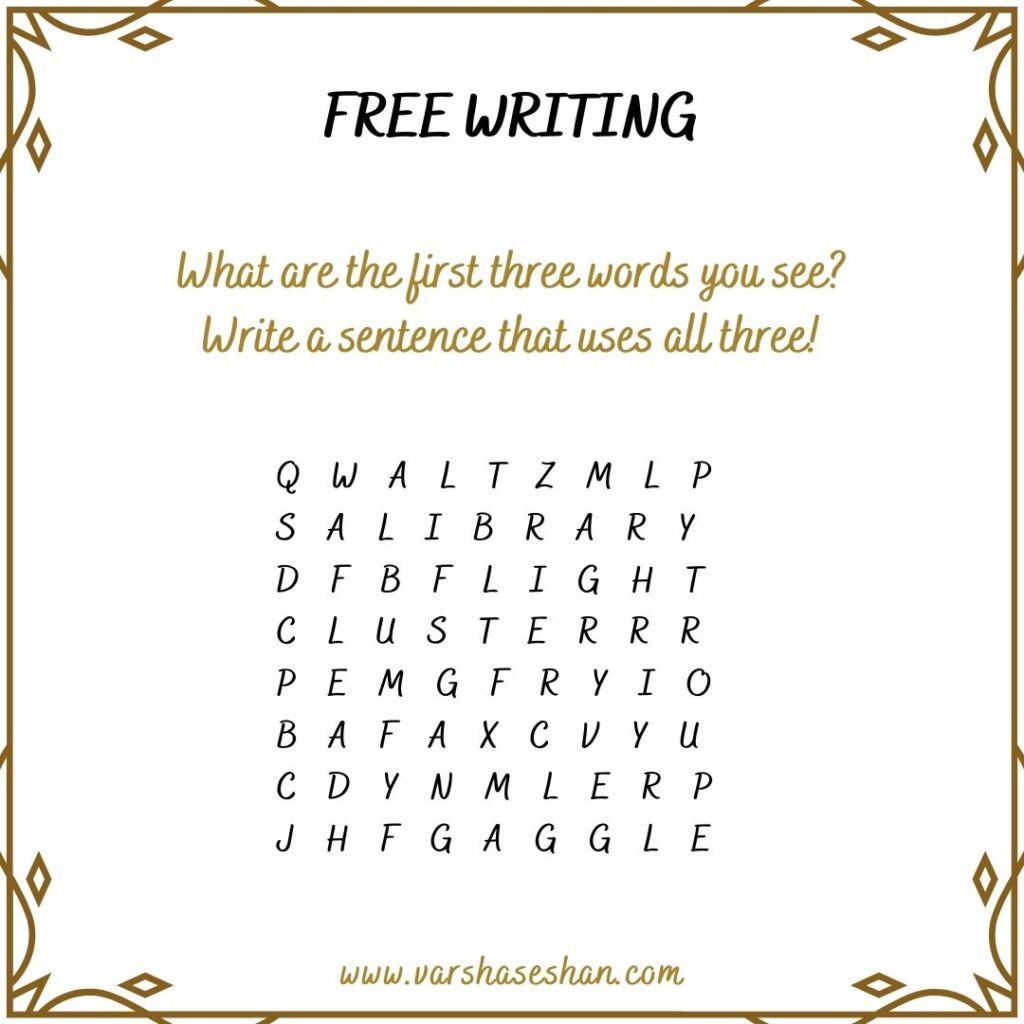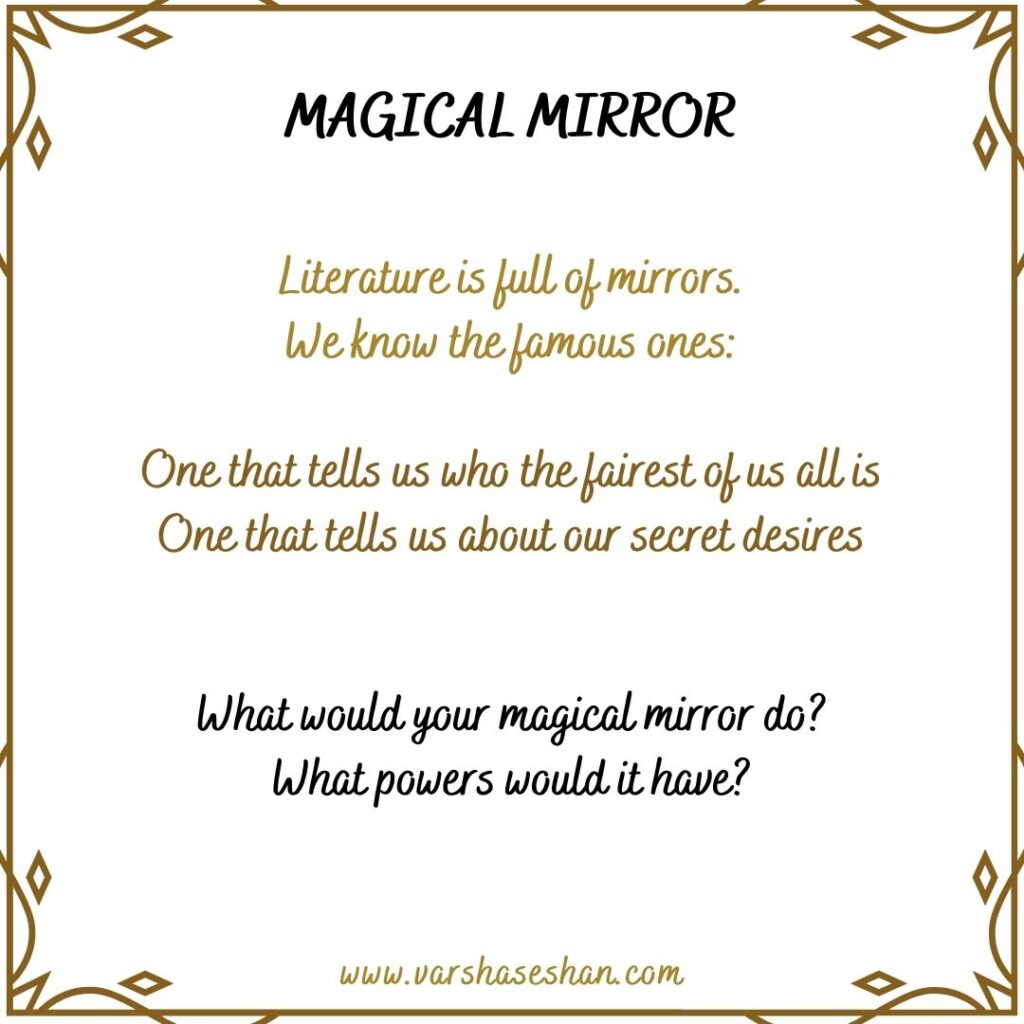Lucky Girl
Lucky Girl is a hilarious book. It’s imaginative, wacky and full of surprises. Sumi is a lucky girl. With her pink bed, a window that overlooks the sea, soft toys and a chef for a mother, she must be a lucky girl, right?
Wrong.
As I chuckled my way through this hOle book written by Shabnam Minwalla and illustrated by Tanvi Bhat, I knew I had to work with it at my reading programme! Here are a few things I plan to do with the book.

Funny recipes
Pammi Gupta makes pumpkin peel muffins and furry leaf parathas for Sumi. Yuck! What kinds of things would you put together to make an imaginative meal? Would you eat the things you can see on the cover of the book? Once you know what the ingredients are, would you still eat them?
Poetry
Sumi takes part in a poetry writing competition organised by Fab Foods. Her friend Priya wants to write one kind of poem while she wants to write another kind. Can you write a short poem about some food that you like?
What’s in a name?
Depending on what recipe book Pammi Gupta is writing, she calls her daughter Sumangali something else.
Baby Dim Sum. Sumacaroni. Sushi.
I’m waiting for the children to play with their own names and come up with new and funny name extensions!
Join my online reading programme
Registrations are now closed for this reading programme. If you would like to receive email notifications when I launch new batches, please fill this form. Alternatively, follow me on social media – Facebook, Instagram and Twitter – for regular updates.
Online Reading Programme – Second Edition!
My Year in Workshops – 2020
Creating Memorable Characters with Sophie
And just like that, the third and last guest session for the current batches of my online writing programme is over. It doesn’t feel like very long ago that I announced the programme, wondering whether there would be enough participants. I did not promise guest sessions because I knew it would depend on the response I received. It needed to be feasible to invite guest speakers, both in terms of the number of participants and in terms of my ability to pay the speakers. But here we go, two batches for two age groups are nearly over!
Sophie’s writing workshop was my third guest session, and it was lovely. Sessions where I learn something about methodology are always extra special. For instance, Sophie worked with excerpts from the classics, something I’ve never imagined doing. She chose tiny sections from Persuasion, The Tenant of Wildfell Hall, The Lord of the Rings and Boy, amongst others, and she invited the participants to pay attention to the technique employed before putting it into practice themselves.
Importantly for me, she worked with representation and the problem with stereotypes. Whose voice gets heard in stories? How often do we write about someone from a different faith? Are disabled characters represented in literature? Are we guilty of using stereotypes when we describe our characters?

Especially with so many children consistently writing about white characters in Europe and America, I loved that she led a discussion about stories set in contexts that we know and the importance of researching contexts we don’t.
I’m already excited about the next batches of my creative writing programme, scheduled to launch in April! A few quick links:
- Find out more about the programme, the fee structure and the outline.
- Receive email notifications about upcoming reading and writing workshops.
- Read about the first guest session with Nalini Sorensen.
- Read about the second guest session with Dr. Sreeja Nag.
- Read excerpts of what participants have to say about the writing programme – reflection one and reflection two.
Workshop Anecdotes
So many little things happen during workshops! That’s what makes them so much fun.
For instance, my reading programme began on Tuesday and I started with Asha Nehemiah’s Trouble with Magic. We spoke about all the wonderful things we’d invent because, in some ways, science and magic are pretty much the same thing.
One child would invent a door. You step through the door and get to whatever place you want to go. You just have to tell the door where you’d like to be.
“And what trouble could you have with magic of this sort?” I asked.
The boy thought for a bit. “If you don’t speak clearly,” he said, very clearly. “You could end up in the wrong place.”
Another child invented this – a vacation machine! Do notice how machine is spelt. Also, I love that the key words are there. No more and no less!

At my writing programme yesterday, I had more fun. The children here are older and I wanted to start a conversation about how we choose names for our characters. I asked them to come up with a nickname for each of the others – including me, if they wanted. I’ve done this activity before and many children are often shy about giving me a nickname. But yesterday was all kinds of delightful.
One girl named me ‘Funsha’. She wanted to use my real name as the root and couple it with a characteristic she associates with me. Isn’t that just lovely?
There’s another girl called Vrinda in the batch, whom she renamed ‘Vrintresting’ because, well, she’s very interesting.
Another girl named me Mia.
After a horse.
She reddened as soon as she realised how that sounds, but quickly explained, “I go horse riding and I love that horse! She’s friendly, calm, patient and just … she reminds me of you!”
I’ve never been named after a horse before, and I certainly never expected to feel so delighted about it!
Creating Memorable Characters
Both batches of my online creative writing programme began in October. Two months out of three have flown by, and I can’t quite believe that I’ve had eight sessions with each batch. We’ve had two wonderful guest sessions too – one with author Nalini Sorensen and one with Dr. Sreeja Nag. It’s time to announce my third and last guest session for this batch, with a multicultural writer-friend, Sophie Gaden.
About the Facilitator
Sophie is a French-Brazilian writer, teacher, and translator. She spent her childhood in Brazil, but at the age of 12, she moved to India where she lived for eight years. As if three countries with three different cultures weren’t enough, she took another step across the world and graduated in English Literature and Creative Writing from Lancaster University. She is now based in London, writing poetry, translating, and teaching English at a secondary school. She is also a poetry translator at the Atelier do Centro in Sao Paulo.
Creating Memorable Characters

What are characters, really? Mysterious beings, figments of our imagination.
How do writers create characters? Why are some characters so memorable? What makes them unique?
Sophie will also be dealing with representation, addressing the need to be more inclusive in our stories. We’ll discuss ideas and explore techniques and activities that will help us imagine and create characters that stay with us long after we close the book.
Details
| Fee | ₹400 per head (UPI: seshanvarsha@okhdfcbank or bank transfer – please contact me for my bank details; my number is in the poster) |
| Age-group | 9-13 |
| Date | 19th December 2020 |
| Time | 4 pm to 5 pm IST |
How to register
This is a free event for all those who have registered for my online creative writing programme. Non participants may join this standalone workshop on payment of the registration fee of ₹400.
This workshop was held on the 19th of December. To be intimated about forthcoming workshops programmes in advance, please fill this form or follow me on social media – Facebook, Instagram and Twitter.
Science Stories with Sreeja
What a whirlwind weekend I’ve had! With the Scholastic Writing Awards ceremony, a guest session at my online creative writing programme, and a weekend workshop for the ten winners of the Scholastic Writing Awards, the weekend has flown by in the best possible way!

As with every guest session, yesterday was special. I’ve invited Sreeja before and I know how exciting conversations with her can be for a group of curious young writers. She’s exciting, warm and generous with her interactions, never dismissing a question or an idea out of hand. For instance, there was a moment yesterday when a child asked her, “Could there be mermaids on some other planet?”
Sreeja paused and then responded, “Why not?”
Sreeja is a scientist at NASA and also leads a team at a start-up that is building and deploying what could be the first self-driving robotic fleet on public roads. She has a PhD in Space Systems Engineering from the Massachusetts Institute of Technology, Cambridge and studies space systems, space robotics for Earth observation, space traffic management, and vehicular robotics validation. That’s about as exciting as it gets for children interested in space stories.
Watching her interact with the creative writing students yesterday was wonderful. I enjoyed her session as much as – if not more than – the children.
As always, I was also struck by all the questions she was asked. Here are a few:
- Does NASA hire artists?
- How do astronauts sleep in space?
- How do they train to sleep in space?
- Don’t astronauts get bored of their jobs?
- Do you think a planet with huge oceans could have enormous creatures?
- Do astronauts ever argue when they’re on space missions?
- How do you get network at the International Space Station?
Guest sessions bring magic to the programme, and a NASA scientist? That’s all kinds of special.
Trouble with Magic
The name itself makes my eyes sparkle. Trouble with magic? That sounds promising! And it is. I giggled my way through the book, chuckling at the hapless Aunt Malu and charmed by the enterprising Veena. Aunt Malu should have known better, but … therein lies the tale!

Why is this book part of my reading programme?
The hOle books are all fun, and I’ve enjoyed everything I’ve read by Asha Nehemiah, so how could I not include her Trouble with Magic in my reading programme?
Imagination
What would you invent if you could invent anything in the world? Do you think that invention of yours is scientific or magical?
Children at my workshops have invented all kinds of things from time machines to superfast shoes and robots that do their homework for them. Aunt Malu is a delightful mix of magician and scientist – neither real nor fantastic – and so, she provides the perfect balance for children who want both realistic fiction and magic. Children are free to imagine anything at all in this realm and I’m waiting to see everything they create!
Actvities
As with Shrinking Vanita, I look forward to linking the real world with the virtual one. Online workshops do have their disadvantages, but they have advantages too because so much stuff is easily accessible. I won’t, of course, get children to make things themselves since I cannot supervise, but I will invite them to look at bottles of interesting things around them and imagine what would happen if they mix them up, in the style of George’s Marvellous Medicine!
Sense perception
Paying attention to the world around us is the first step towards making sense of it. What happens to snow in the heat? What happens to leaves in the wind? How do we link these sounds to our emotions? With its effusion of colour and sound, Trouble with Magic allows for much sensitivity to the world around us.
A little about the book
There’s never a dull moment when nine-year-old Veena is around, but Aunt Malu should know better than to go along with the girl’s zany ideas. Veena’s ideas always lead to unexpected results. Free season passes to the circus, for instance, involve cleaning out lion cages with the lions in them. Adopting pets leads them to take in a lame mongoose that keeps stealing food from the neighbour’s kitchen.
Trouble with Magic is a hilarious book, a rollicking ride in the company of a fun aunt and an incurably optimistic girl.
Registrations are now closed for this reading programme. If you would like to receive email notifications when I launch new batches, please fill this form. Alternatively, follow me on social media – Facebook, Instagram and Twitter – for regular updates.
The Sheep-Pig

A few months ago, one of my publishers, Mango Books, began a series of posts on social media about books authors read when they were young. The book I chose was The Sheep-Pig, a delightful chapter book by a favourite writer, Dick King-Smith.
Dick King-Smith’s stories are a treat. I loved The Sheep-Pig, the sequel Ace and so many more – Saddlebottom, A Mouse Called Wolf, The Hodgeheg … Every time I went to the library, I would look out for his books, hoping to discover at least one more book I hadn’t read.
Why is this book part of my reading programme?
Obviously, the first reason is that I love it. Here’s what I said to Mango Books about it.
“The Sheep-Pig is a delightful story, and I’m so glad I read it as a child! The book left me with the feeling that anything is possible. More than that, I loved the idea that kindness and courtesy can help you achieve anything. The Sheep-Pig shatters all stereotypes about pigs being dirty, greedy and stupid because the protagonist Babe is the perfect pig – clean, unfailingly polite and utterly charming. The story stayed with me because of its gentleness, its humour and its wonderful portrayal of friendship–all of which I hope find their way into my writing too!”

Discussion
From the importance of being polite to ideas of stereotypes, daring to be different and following instructions, The Sheep-Pig can spark all kinds of conversations. Why does Babe succeed where others fail? How do people see you? Do you fit in with their ideas? The Sheep-Pig is a wonderful text to work with when it comes to a range of subjects!
Puzzles
Many children find reading boring because there’s nothing to do. Mazes and puzzles help them to keep their minds active as they figure out best possible routes, and The Sheep-Pig, with its trail routes and shepherding storyline is perfect for more than one quick activity on problem solving.
Word games
Babe gets confused by the word ‘ewe’. He wonders what the sheep Ma means when she says ‘I am you’. Homophones can be confusing, but playing with them is fun! I’m waiting to work with rhymes, homophones and more at the reading programme.
A little about the book
Why can’t I learn to be a sheep-pig?
Babe, The Sheep-Pig
Mr Hogget wins a piglet at a fair, but he’s never had pigs before. His sheep-dog, Fly, takes the piglet under her wing and like all children, the piglet begins to imitate the closest adult. It so happens that the closest adult is not a pig, but a sheep-dog. Why should that stand in the way? If the piglet’s adoptive mum can be a sheep-dog, why can’t the little one be a sheep-pig?
The Sheep-Pig is an award-winning book by a beloved author, well worth a read, a re-read and then a few more re-reads after that.
Registrations are now closed for this reading programme. If you would like to receive email notifications when I launch new batches, please fill this form. Alternatively, follow me on social media – Facebook, Instagram and Twitter – for regular updates.
Shrinking Vanita
Reflections – Part 2
A Few More Writing Activities
Five Writing Activities for Children (and Adults!)
Stories of Space Robots and Rockets
A couple of weeks ago, I found myself thinking – an online writing programme is not a lit fest. Wouldn’t it be wonderful to invite people who would be able to do something entirely new? What could I do to bring in a new kind of story?
And here was my answer:

How can I make my science fiction story believable?
Do we need more stories about women in science?
| Fee | ₹400 per head (UPI: seshanvarsha@okhdfcbank or bank transfer – please contact me for my bank details; my number is in the poster) |
| Age-group | 9-13 |
| Date | 5th December 2020 |
| Time | 10 am to 11 am IST |
About the guest facilitator
Sreeja Nag is a Senior Research Scientist at NASA Ames Research Center, where she leads a project called D-SHIELD. She is also working on what could be the first self-driving robotic fleet on public roads. Sreeja completed her PhD in Space Systems Engineering at the Massachusetts Institute of Technology, Cambridge. Her research interests include distributed space systems, space robotics for Earth observation, space traffic management, and vehicular robotics validation.
She grew up in Pune, Maharashtra and completed her undergraduate studies in IIT Kharagpur in India before moving to the United States. She currently lives in the San Francisco Bay Area in California.
How to register
This is a free event for all those who have registered for my online creative writing programme.
Edit: This event was held on the 5th of December. Look out for all workshop announcements on my blog, or on social media (Facebook, Instagram and Twitter). To receive information about my reading and writing programmes via email, please fill this form.
Writing Stories with Nalini Sorensen
Guest sessions are full of fun! Yesterday, I went on not one, but several writing journeys with children’s book author Nalini Sorensen. What did I take back from my journeys? Several things, actually!

For one, I love Nalini’s phrase ‘story eyes’.
Just like Nalini, the question I hear most often is ‘where do you get your ideas from?’ Nalini made us close our eyes and imagine an incredible experience. She took us on a journey to the top of Mount Everest, a journey that’s unique, special.
And then, she told use that we didn’t need experiences like that to create stories. All we needed were our story eyes. Look around with story eyes, and even mundane events can become stories.
Already, during my writing programme, children have been concerned about uniqueness. What if we copy someone else’s story by mistake? Will we get into trouble? Isn’t it possible for more than one person to have the same idea?
Even though Nalini didn’t hear these questions, she answered them as she spoke about how perspective matters. Perspective can change everything, and that is what makes your story unique.
This guest session was just the beginning. Follow me on social media to find out about upcoming workshops – Facebook, Instagram and Twitter. To receive information about my reading and writing programmes via email, please fill this form.
Online Reading Programme
Reflections – Part 1
During the course of any creative writing programme I conduct, about two or three times, I ask children to stop and reflect on everything they’ve felt and everything they’ve done during their sessions with me. Now that we’re one month into my online programme, it was time. And as usual, I could not stop smiling when I read their work.
Afreena, 11, listed everything she’s learnt – from acrostic poems to rebuses. She remembered the list poem she wrote, the limericks we read and all the literary devices we worked with. Her reflection was simple, clear and straightforward; I loved it.
Sunandini, 9, did something quite beautiful – she wrote a story! The whole story was a grand metaphor for the creative writing programme and I can quite honestly say that I’ve never read such an original reflection! Here are a few snippets.
A few weeks back, I boarded The Great Grammar Express. I walked to my compartment and opened the sliding-door. Inside, a girl with a green suitcase was settling in. I sat down on the spacious berth opposite to the other girl’s. A lady with short hair got in the compartment and said ‘I am your instructor for this writing journey, Ms. Vanessa’.
I’ve shortened it a bit, but isn’t that just a lovely beginning? The reflection continues in the same vein. Read on!
After a while we stepped out of the train [since it had stopped] for a short walk. We found we were in the limerick lane and actually discussing limericks by Edward Lear. The train then whistled and we rushed to get in. Once settled, we tried our hand at writing a five line limerick. I felt I could have written a better limerick with a second try.
I’m not going to share the whole thing here, but I can quite honestly say I enjoyed reading all of it. Sunandini also shared answers to a few questions I asked to push them to write their reflections. The piece she feels was the best she wrote is one that I admired too.
A little background before I share the poem: we used Shel Silverstein’s Magic to work on strong verbs. I love his teaching resources; they serve as wonderful material for poetry workshops. After reading his poem, I asked the girls to write a poem of their own, which uses eight strong verbs in two sentences – look what Sunandini came up with.

And finally, a reflection like this, from 10-year-old Ruchiranana, always warms my heart. How can I not be happy when a child says there was nothing she didn’t like during five hours with me?

As each session goes by, I’m so glad I ventured into this online creative writing programme. It gives me so much joy!
If you would like to find out more about the programme, please click here, or follow me on social media – Facebook, Instagram and Twitter. To receive information about my reading and writing programmes via email, please fill this form.
Writing Stories with Nalini Sorensen
Each morning, among the first things I do is visit my creative writing forum. I love it. I love that every day, there are new pieces to read, all shared by young writers who are part of my online creative writing programme. I’ve done four sessions with one batch and three with another; it’s time to bring a little more excitement in – a guest session!
I spoke to author Nalini Sorensen, and we finalized things super quickly. I’m delighted to announce a one-hour writing workshop with this warm, lively, award-winning writer. While the event is free for those who have enrolled for my online programme, it’s open to non-participants too, on payment of a registration fee.

Edit: This event was held on the 19th of November. Look out for all workshop announcements on my blog, or on social media (Facebook, Instagram and Twitter). To receive information about my reading and writing programmes via email, please fill this form.
How to Write a Limerick
What is a limerick?
A limerick is a (usually humorous) five-line poem with a strict AABBA rhyme scheme. It’s fun to write and, usually, fun to read. I’ve always loved limericks by Edward Lear, and over the past few years, I’ve read many, many more. Do you remember the nursery rhyme ‘Hickory Dickory Dock’? That was probably the first limerick most of us learned!

Why should I write a limerick?
While I can’t give you an answer to that, I can tell you why I work with limericks so often at creative writing workshops I conduct.
- Limericks are fun.
- Limericks are funny.
- Limericks have a definite structure, which forces us to pay attention to both rhyme and meter. Read more about that here.
- Limericks are short, with no room to wax lyrical.
What do I need to know about limericks?
The best way to understand the form of a limerick is to read dozens – or hundreds – of limericks for yourself. Feel the meter and the rhyme scheme, instead of learning the rules I’ve listed below!
- A limerick has five lines.
- The rhyme scheme of a limerick is AABBA. This means that the first, second and fifth lines rhyme with one another and the third and fourth lines rhyme with each other.
- The length of the lines also follows the same pattern. The first, second and fifth lines are longer and have three stressed syllables each.
The third and fourth lines are shorter and have two stressed syllables each.
How do I go about it?
As with any other kind of writing, begin with an idea. Perhaps you could write a limerick about yourself!
- The first line should introduce the main character – that’s you!
- The second line should bring humour in. Think about your quirks (strange habits or funny things you do!).
- The third and fourth lines need action. Use good, clear vocabulary.
- The fifth line should not leave the reader hanging. You need a resolution.
Look how I gave it a shot!
I am the main character of my limerick. What odd habits do I have that I can have fun with? What action can I bring in, and how do I finish my limerick with a good punchline?
Here’s one of the limericks I came up with:

What makes a limerick difficult to write?
Lots of things, actually! It took a while for me to realise that I would struggle if I chose to write about more than one character. For me, five lines aren’t enough to do anything meaningful with multiple characters!
The meter of a limerick is challenging too. I had lots and lots of ideas, but with such short, defined lines, it isn’t easy to make the poem work.
I don’t like “adjusting” poems. For me, rhyming verse should be easy to read aloud. Else, it just doesn’t work!
Go on, try a limerick of your own. Share it with me if you’d like to!
Creative Writing with Children
Every time I work with children on creative writing, I realise why I enjoy it so much. Each interaction is full of laughter, fun, and most joyous of all–moments when children finally understand something and it shows on their faces. I’m still elated after yesterday’s online creative writing session!
Since I launched the programme on the 5th of October, I’ve had a regular routine. Early in the morning, I log on to my forum. What will I find? Which of the writers would have contributed something delightful?
One morning, I discovered a letter to be placed in a high technology envelope that could be opened and closed with a button. Another morning, I discovered a list of words that one of the young writers loves – goofy, amazing, surprise … And soon, I will find a set of limericks. I can’t wait to read them!
Yesterday, as usual, my session was full of all kinds of activities. I love exploring ways to keep the children engaged during an online interaction, and I wanted to work with synonyms. I chose the word ‘happy’ to start the conversation and used the white board for the first time, inviting them to work together on a word search puzzle. I had to bite back my smile when I saw the poor white board at the end of the session.

Rhyme, rhythm, meter, homophones, alliteration, tongue twisters, limericks … That’s what we’ve done so far in just two weeks. The next ten weeks promise to be exciting.
And on that note, a reminder: registrations are still open for the age-group 12-14 for the batch that begins on Thursday the 15th of October. Click here for more details. I can’t wait for it to begin!
Online Creative Writing Programme (ages 9 to 11)
Please note that registrations are now closed for this batch. To find out about the next batch for this age-group, please fill this form, or follow me on my social media handles – Facebook, Instagram and Twitter.

Outline
- Different kinds of poetry
- Making a story engaging
- Creating believable characters
- Working with plot and setting
- Genre
- Structure
- Dialogue writing
- Editing and publishing
Details
Age-group: 9-11 years
Start Date: 5th October 2020
End Date: 28th December 2020
Online Interactions will be held every Monday from 4 pm to 5pm. Please note that Monday the 16th of November will be a holiday for Diwali.
Fee: ₹15,000 per participant (payable via UPI to seshanvarsha@okhdfcbank or bank transfer. International payments may be made via PayPal to seshanvarsha@gmail.com)
This includes 12 online interactions, access to a private forum to share writing and individual feedback for each piece.
Maximum of 12 participants per batch.
Online Creative Writing Programme (ages 12 to 14)
The Chat Box
I love virtual school visits. I enjoy talking to children about my books, encouraging them to explore reading and writing, and taking them through my journey as a writer. Visiting schools virtually was such a novel experience that I wrote an essay for The Curious Reader about it. But of course, as virtual visits go on, more stories are created. That’s the fun of working with children, isn’t it?

Recently, I did a session with a group of about 200 children. I know from experience that it’s important to lay down the rules at the outset, and one of the rules is no mics. If 200 children switch on their mics, there’s utter mayhem. Most children are now used to the idea, but at this school, the session was rather chaotic to begin with. In the beginning, before the session began, I did answer a few questions out of turn but as more and more participants joined in, I shook my head and kept repeating, “Use the chat box. If you have a question, use the chat box. I can’t hear 200 of you at the same time. Use the chat box.”
A few children did have questions. Of all sorts.
Why are we here? (Um …)
When will the session get over? (This, before we’ve even begun.)
Is class V B supposed to come? (Um …)
Who is the teacher in the room? (I wasn’t sure how to answer that.)
Slowly, they settled down, with several more “Please use the chat box” instructions from me.
About fifteen minutes into the session, when everything became a little quiet, a tiny voice piped up, “But … Where is the chat box?”
Ah. Another day, another lesson learnt.
The Writers’ Club 2019-20
I can’t quite believe it’s been five years with the Writers’ Club at St. Mary’s School. I remember we had a maths teacher in class V who had been teaching there for FOUR YEARS. And I thought that it was pretty much forever. I’m there now.
My first batch was created for the sesquicentennial celebrations, and it led to the publication of Flickering Flames.
In the second year, we put together a book of our own, handmade, and we called it The Book that Speaks.
And in the following three years, I held a writing competition, with the results being announced during the very last session. Last year, I also invited a special guest to give away the prizes – and what fun that was.
This year, my batch was particularly enthusiastic and we had not one but two parties – one for Christmas and one yesterday for our very last session. I love how excited all the girls are about the competition results, even those who submitted nothing! Each year, I ask two girls from a previous batch to judge the entries. I provide them with detailed assessment criteria, and they take the process of judging seriously, which makes me glad. Each year, I enjoy reading their comments, discovering yet again how subjective judging is. This time, we had fewer entries than usual, but the results were just as eagerly anticipated. The two girls who won were thrilled; it’s grand how important it is to them.
And then, we went back to working on magazines, which is what we have been doing for the last three combined sessions (sessions for which I invite those from previous batches). I was so struck by some of their ideas! For instance, one girl insisted that the inside cover COULD NOT have the credits because it had to have an ad. So, she made an ad and somehow fit the masthead in too. Without that, she was convinced, her magazine would not look authentic.

I also realised how disconnected children are from the world of money. For instance, when a pair of them discovered that a magazine has a price marked on the back cover, they wondered whether to put ₹1,500 rupees as their price, only to learn that Champak costs ₹25! They made a joke of it and decided to price it at ₹1,500-million-crore. Which they felt was justified by the amount of work they put in.
We had magazines about dogs, activities, Harry Potter, book series, brands … I was amazed at the number of things they came up with. It took some prodding, of course, used as they are to the idea of making a school project. Some began by choosing topics like ‘deserts’ and ‘temperate zone’. We moved from there to more imaginative ideas, though many magazines were left incomplete. The girls promised to finish them in the holidays – we’ll see.
And that’s that. Another year of stories, plays and poems comes to an end. Each year brings me so much joy!
World Read Aloud Day 2020
Five days late, but why can’t every day be read aloud day?
I happened to have a session with my Writers’ Club on World Read Aloud Day, so each of the girls chose something to read. It was delightful! Above all, I was struck by how well most of them read, without burying their faces in their books and without too much stuttering and stumbling. That is privilege, isn’t it? That level of fluency?
Also, this time, I loved that nearly all of them chose their pieces well.
While last year, I had children struggling to read an abridged version of King Lear aloud, fumbling with names like Cordelia and Goneril, this time, I found that their choices were, on the whole, quite good! Some read easy poetry; I had a couple of stories about Akbar and Birbal, and we had excerpts from Nancy Drew and Enid Blyton. I have written earlier about why children choose texts that are too difficult for them; I’m glad that did not happen this time!
And this year, I read an excerpt from The Prophecy of Rasphora to celebrate World Read Aloud Day. And unlike last year, I didn’t foolishly call it World Reading Day. In case you haven’t seen it yet, take a look.
I also used the occasion as an excuse to do something I’ve been meaning to do for a while. I enjoy working with the book in class, exploring language and having fun with words. So, I decided to put a free printable handout online. Here it is. And if you’d like to read reviews of The Prophecy of Rasphora and find out a little more about the book before you decide to use it in class, here you go.
A Theme-Based Reading Programme
A couple of months ago, I wrote a blog post for StoryWeaver about a training programme I have been conducting for the last three years for librarians in Mumbai and Navi Mumbai, and the ways in which I use StoryWeaver and Pratham Books for the reading programme they implement in schools. I have grown so much through the workshops I purportedly conduct! Working with a range of librarians with limited resources has been an eye-opening experience for me, an experience that I treasure. Each year, I tweak the programme slightly, trying to make it more accessible to every level of learner and easier to implement.

This year, I continued with a theme-based approach, but I chose themes that were clearly linked with the needs of reluctant readers. How delighted I was when I learned about how the librarians took the ideas to their schools!
Linking the reading theme with the overall curricular theme ‘Cleanliness’, the story A Cloud of Trash was selected. For two weeks, the libraries focused on character emotions, then they moved on to identifying the problem in the story, discussed synonyms and antonyms and then tried to discover the solution.

And finally, the children were involved in a task that demonstrated their understanding.
- They presented a skit, trying to imagine what happened next
- They made a fresh book cover for A Cloud of Trash
- They made a poster for their school to highlight the importance of cleanliness
- They made their own stories and comics about cleanliness
- They created picture books of their own, revolving around the idea of a cloud of trash

My next training session with the librarians is two days away and I can’t wait to see what magic they will bring next to their classrooms!

Dear Fictional Character
Yesterday, to round off our letter-writing activity, we wrote two more letters.
One began with ‘Dear Reader’, and this is an activity I’ve done more times than I can count. I tweaked it slightly this time because of the idea of posting their letters to them. Instead of telling them that what they wrote would go into books in the library, I told them their letters would go in the mail to someone else in the room. They enjoyed it tremendously!
(Here is an explanation of the activity, plus a link to a video you could use.)
The second was a letter to a fictional character. I asked the children to choose any fictional character they love, and write a letter, sharing whatever they liked with that character. Among all the letters to Hermione Granger, Tom Gates, Silky (Faraway Tree) et al, here’s one letter I found:

I couldn’t stop chuckling at this! Of course, I’m thrilled that she chose to write to Chitra from my railway adventures, but more – I love that the most important thing she would like to share is about her pet cat Melody!

Chitra would love to read this, I think. I also find it interesting that Deven, the eldest of the four cousins in the series, is forgotten. Ah, the joys of being a writer and getting sneak peeks into readers’ minds!
Letter-Writing at the Writers’ Club
I’ve been waiting to do this activity ever since I thought of it, and it was well worth the wait — particularly because two children said this was the best Writers’ Club session ever!
Receiving a letter is lovely. I enjoy every part of it – the anticipation, seeing something in the postbox, seeing that it is addressed to me, opening it and reading it. That’s why I decided to bring that to the Writers’ Club. I asked each of the girls to bring an envelope to class; I brought the rest.

For me, the first and biggest surprise was that children don’t know how to address an envelope! My instructions were poor – simply because I didn’t realise how clueless they would be. Many children wrote the address at the back of the envelope. Several others wrote their names in big bold letters and then somehow squeezed the address in below. Many didn’t know that a stamp would normally be stuck at the top right corner, so they wrote all over the envelope!
The activity itself was fun; it’s a variation of a grammar activity I often conduct. Each child has a sheet of paper on which she writes a question beginning with ‘what’. She folds it and passes it on. On the passed-on sheet she receives, she writes the answer to the question she asked, then she folds it and passes it on. Next, she writes a ‘who’ question and the same process follows. When we unfold the sheets, there’s always much hilarity! And this time, instead of unfolding and reading aloud, I will be posting them to the young writers.

After that, we also wrote a letter that began ‘Dear Future Me’, which I promised I would not read. Some wrote long letters; others just wrote notes – and they’ll get them in the mail!
They’re going to write one more letter during my next session with them, and then we’re done. I’ll post all their letters and we’ll see how they react when they receive them!
Meanwhile, last week, I also conducted a skill-building workshop for English teachers at Aurangabad. That was another fun event. I’ll do the same session soon in Mumbai and Pune too!

Characters at the Writers’ Club
Excitement is so contagious! The Writers’ Club was full of energy today because of two activities we did based on the idea of how characters come alive to readers.
A week ago, I asked the girls to think of a character they would like to present to the rest of the club. We had a few rules and then, because we had about a thousand questions, we had a few more rules.
The bottom rule was this: try to make it fun for everybody. To work towards that, we had a few ‘suggested’ rules:
- Don’t say too much; don’t say too little
- Don’t choose obscure characters
- Don’t make your speech more than two minutes long
- Don’t read out a speech
As we went on, more rules were added, but eventually, today, many of the girls had (of course) forgotten everything. Some had forgotten to think about a character at all, and two were too shy to come forward unprepared.

Yet, we had Harry Potter, Geronimo Stilton, Captain Haddock, Slappy (Goosebumps, no, I didn’t guess this one), Phileas Fogg, Gulliver, Fantastic Mr Fox, Joe from the Faraway Tree … It was lovely. I did something similar a couple of years ago too, as a kind of Children’s Day celebration, but each set of young writers brings something different to the Writers’ Club, a different sort of excitement and energy.
Plus, this year, I took the activity one step further. Once everyone had revealed her character, I wrote the names of the characters down on sticky notes that I pasted randomly on girls’ backs. This almost didn’t work because the notes kept falling. But the children were so enthusiastic that they came to me with paper clips and asked me to clip the notes onto their backs.
Asking each other participant a maximum of one question, which had to be answered in a maximum of two words, they had to find out who they were. Of course, the one question they weren’t allowed to ask was ‘Who am I?’.

Utter mayhem ensued, but of the fun kind. Everyone was absolutely delighted at the end of it, including me!
Using Pratham Books and StoryWeaver in School Libraries
This post first appeared on the StoryWeaver blog on 9 October 2019.
As a British Council trainer, I’ve conducted numerous reading workshops and facilitated many interactive sessions for theme-based reading challenges. I’ve worked in schools as well as at the British Library itself, interacting with a range of children, from those who devour books to those who yawn at the sight of a library.
So, when Anubhooti Learning Solutions (then ‘Experiential Learning Solutions’) asked me whether I would chalk out a reading programme to be administered by librarians at municipal schools in Mumbai and Navi Mumbai, I was interested. The project was a CSR initiative by D-Mart and the crux of the idea was to support a few schools through a library programme.
Excited, I drafted a detailed outline of what we could do. I devised a theme-based approach with detailed assessment criteria, for that was something that the reading programme team felt was crucial. I also worked out the learning outcomes, outline and structure of three training sessions for the librarians. All of them had worked in different capacities earlier and were to be associated with the library space for the first time. The purpose of my training sessions was to introduce them to their role beyond classroom management and discipline, emphasising that inculcating the habit of reading and a love for language is as much a part of a librarian’s role as the issue and return of books.

Yet, it was only as we launched the programme and began the first workshop that I began to understand how many problems the librarians face. A theme-based programme with assessment criteria was all very well. How would we deal with the other big issues, including the fact that many children did not even attend school regularly? As we went on, there were three problems that I was determined to address through the reading programme:
- One, children come from multiple linguistic backgrounds. For instance, in a predominantly Hindi-speaking area, children attend a school where the medium of instruction is Marathi. “In my class of forty, only five children speak Marathi,” one librarian said to me.
- Two, every class has students with varied reading levels. “The children who have been with us for some time are okay, on the whole, but new children come in all the time. If a child is ten years old, the school administration puts him in class five, even if he has not even learnt the alphabet yet!”
- Three, some schools have different languages of instruction running concurrently. “My first period is with Hindi-medium children, then semi-English, then Marathi, then Hindi again. Each week, I have Urdu-medium, English-medium, Hindi-medium and Marathi-medium children coming to the library!”
What could we do? How could we hope to tackle such a wide range of problems?
Additionally, what started as a small group of eleven librarians soon began to grow. This is the third year of my association with Anubhooti and the D-Mart initiative, and we work with 47 librarians: D-Mart now supports 68 schools through its reading programme.
It is at this stage that my use of StoryWeaver in libraries comes in. D-Mart’s vision for the reading programme includes providing a minimum of 200 hard copies of Pratham Books in three focus languages (English, Hindi and Marathi) for each library that it supports. Five schools also use StoryWeaver books offline. This was a huge boon to me, for at least I had a starting point. I could access the same story in many languages, and thanks to the Creative Commons licence, I could encourage teachers to work with each story in multiple ways. Teaching requires so many resources that access to free material is invaluable!

Reading Levels
I was first attracted to StoryWeaver by the clear levelling of stories, and so, this was the first thing I introduced to the librarians too. In a single class, librarians deal with students struggling to read the alphabet as well as students who read stories confidently. With such a wide range of readers thrown together in one room, I find it particularly relevant that the reading level of books on StoryWeaver is not clearly linked to an age-group. This is important to me because slow learners are often targets for bullies. Reading a “kiddish” book, marketed as one for younger readers, leads to the shaming of slow learners, and a simple indication of reading level rather than age is an important step towards addressing (though not solving) this problem.
The first time we used StoryWeaver, we worked with three stories I love – I Am Not Afraid, Ammachi’s Amazing Machines and Farida Plans a Feast. We read each story many times, in three languages. Bilingual books are particularly wonderful in the context of this reading programme, for when a child is required to read in one language, even though s/he is more comfortable in another language, having both on the same page is a great aid to reading comprehension. All of us loved the simplicity and artwork of I Am Not Afraid. It allowed us to explore and enjoy the story without being daunted by complexity of narrative and vocabulary.
The main activity we engaged in after reading the books was to create simple stories of our own. Inspired by the sweet simplicity of I Am Not Afraid, librarians created wonderful picture books about conquering fear. This was just the first step because they took the idea back to their libraries and asked children to make books of their own. This was a huge boost to the reading programme, as it encouraged children to read more and write more. The most wonderful outcome was that even if they read nothing else, children wanted to read what their friends had created. An added bonus was that there were suddenly many more books in the school library!
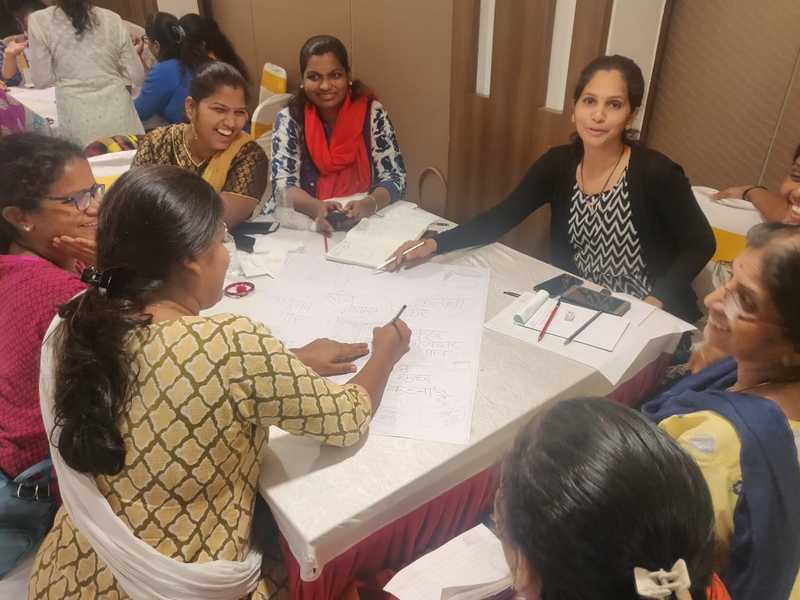
Wordless Picture Books
Wordless picture books are all kinds of lovely. We “read” the charming I Can Dress Myself! and then looked at how to work on language skills using a book that is written in none of the focus languages. Beginning with simple questions and answers – giving the girl a name and naming all the pieces of furniture in the room – we went on to a storytelling session, where the pictures in the book became visual aids.
Next, to continue our exploration of the use of StoryWeaver without language, I showed the participants Deepa Balsavar’s vibrant picture of a busy market. With so much happening in a single image, the librarians could explore a range of vocabulary. Consequently, they came up with various ideas of how they could use pictures in class to increase attention and concentration. We discovered that wordless picture books and the visual treat of any detailed image would include both children with very low language proficiency and confident readers who want something new.
Lists
The lists on StoryWeaver allowed me to modify the reading programme in the third year, making the entire programme much more accessible. In the first year, the feedback I received from the librarians indicated that a huge majority of older students did not want to read fiction. Working with non-fiction and stories that clearly reflect the world we see around us thus became important to the reading programme as we moved forward.
And so, for the third year, I chose to begin with three themes – Environment, Science and Technology, and Mathematics.
For the first theme, we read What’s Neema Eating Today? in English, and A Cloud of Trash and Anand in Marathi. Once we had read all three stories, it was time for our next activity.
In groups, the librarians chose a story to work with and present in a novel way. Some took the story further, imagining what would happen next. Others analysed the story in different ways, changing the setting to their own schools. Soon, through skits and quizzes, we had Chhakuli (the lead character in the Marathi translation of A Cloud of Trash) sorting out the garbage problem in a neighbouring village. We had Anand talking to his friends about taking pride in his work, and about there being no shame in working as a rag-picker. We had questions and answers about character motivation and themes. We discussed segregation of garbage and the role each of us must play in the process.

For Mathematics, we read It’s a Laddoo Party! enjoying the repetition and humour in the tale. Working with maths stories was an intriguing idea for many, one that they could not wait to take to their classrooms.
As a quick recall activity for vocabulary, we also played a ballgame. When a ball is thrown to a participant, s/he must quickly say a word that is clearly related to one of the four stories we read. So we remembered what Neema ate, recalled characters like Peter Uncle and Mihir, and discussed seasons of the year.
What happens next?
While I work with only the librarians, the proof of the pudding is, of course, in the eating. As the librarians do not have easy access to audio-visual equipment, working with StoryWeaver remains, for the moment, limited to schools that have computer labs with books downloaded on the systems. Children read independently – either using StoryWeaver offline or hard copies of books in the library. Eventually, I hope that infrastructural changes will allow librarians to use StoryWeaver to the fullest, including the Readalong feature and YouTube channel.
Yet, exposure to all this material has ensured multiple gains. For one, the librarians themselves have begun to read. Their purpose is clear: using stories actively in the library so as to move beyond the rather monotonous role of distributing and collecting books. Secondly, a theme-based approach allows them to look at books in their collections in a new light and create new books that then encourage reluctant readers. Thirdly, access to the same book in all three languages makes the act of reading less daunting, especially when it comes to reading in a language that is not one’s mother tongue or first language.
And finally, feedback from the reading programme team at D-Mart is promising. Librarians and programme managers assure me that children now enjoy the books tremendously, and isn’t that the greatest victory of all?

